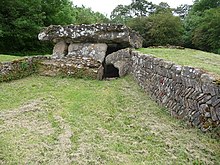
Back Tinkinswood Welsh Tinkinswood German טינקינסווד HE Tomba Tinkinswood Italian Gravkammeret i Tinkinswood NB Тинкинсвуд Russian
 | |
| Location | St Nicholas and Duffryn Rural Communities |
|---|---|
| Region | Vale of Glamorgan (Bro Morgannwg), Wales (Welsh: Cymru) |
| Coordinates | 51°27′4.96″N 3°18′29.17″W / 51.4513778°N 3.3081028°W |
| Type | Dolmen[1] |
| History | |
| Periods | Neolithic |
| Site notes | |
| Condition | good with some damage |
| Official name | Tinkinswood Burial Chamber[2] |
| Reference no. | GM009[2] |
Tinkinswood or its full name Tinkinswood Burial Chamber (Welsh: Siambr Gladdu Tinkinswood), also known as Castell Carreg, Llech-y-Filiast and Maes-y-Filiast,[3] is a megalithic burial chamber, built around 6,000 years ago, during the Neolithic period, in the Vale of Glamorgan, near Cardiff, Wales.
The structure is called a dolmen,[1] which was the most common megalithic structure in Europe. The dolmen is of the Severn-Cotswold tomb type,[3][4] and consists of a large capstone on top, with smaller upright stones supporting it. The limestone capstone at Tinkinswood weighs approximately 40 long tons and measures 24 feet (7.3 m) x 14 ft (4.3 m);[3] it is thought to be the largest in Britain, and also in Europe.[5][6] It would have taken some 200 people to lift the stone into the correct position.[3] It was originally all covered by a mound of soil, which has been removed over time. The remaining mound behind the structure measures approximately 130 ft (40 m) x 59 ft (18 m) in size.[3]
- ^ a b ""Tinkinswood Burial Chamber" Waymark". Groundspeak Inc. Retrieved 30 May 2008.
- ^ a b Cadw. "Tinkinswood Burial Chamber (GM009)". National Historic Assets of Wales. Retrieved 26 October 2021.
- ^ a b c d e "Tinkinswood". Paola Arosio/Diego Meozzi. Retrieved 29 May 2008.
- ^ Cite error: The named reference
Woodwas invoked but never defined (see the help page). - ^ "Tinkinswood Burial Chamber". Cadw. Retrieved 29 May 2008.
- ^ "Tinkinswood". John Harding. Archived from the original on 5 October 2009. Retrieved 29 May 2008.
